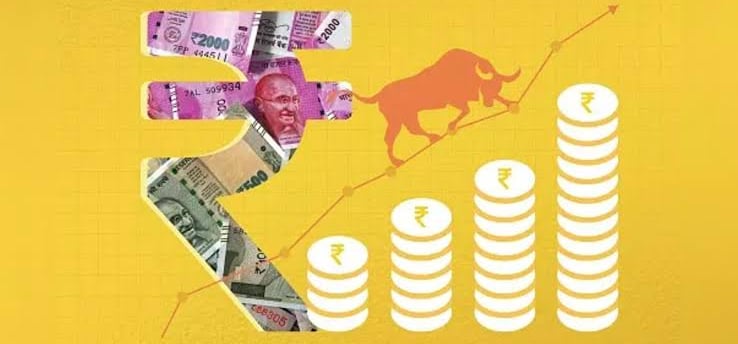Add your promotional text...
India's Economic Evolution: Market Capitalization Soars, Industries Realign, and Services Rebound
Synopsis: India is undergoing a dynamic economic transformation characterized by a significant rise in market capitalization, a shift in industrial dominance, and a robust recovery in the services sector. This evolution is driven by proactive government policies like the PLI scheme, substantial infrastructure investments, and the country's growing prominence as a global business hub. As these changes reshape India's economic landscape, the nation is poised for sustained growth and increased global influence.
MARKETSINDIA
By Sameer Malhotra
8/19/20243 min read


India is experiencing a profound transformation in its economic landscape, characterized by a significant increase in market capitalization, a realignment within the industrial sector, and a strong rebound in the services industry. These changes are reshaping the country’s economic profile and positioning it as a formidable global player.
A Surge in Market Capitalization
As of December 2023, India’s market capitalization has reached a remarkable 124% of its GDP, a substantial increase from 77% in December 2019. This growth reflects the robust performance of the Indian stock market and the increasing value of publicly traded companies. The surge in market capitalization is not just a sign of investor confidence but also indicative of the overall economic growth and expansion of corporate India.
Industrial Sector Realignment
The industrial sector in India is undergoing a significant shift in its output composition. Traditional industries like textiles, food products, beverages, and petroleum products, which once dominated the industrial landscape, are now witnessing a relative decline. In contrast, sectors such as chemicals, pharmaceuticals, transport equipment, and steel are emerging as new powerhouses, driving industrial growth and contributing more significantly to the economy.
This shift in industrial output has also impacted India’s trade dynamics. Sectors like steel, pharmaceuticals, and automobiles have become major net exporters, contributing positively to India’s trade balance. On the other hand, industries such as coal, capital goods, and chemicals still rely heavily on imports, highlighting areas where domestic production needs to catch up to reduce dependency on foreign goods.
The Impact of the Production Linked Incentive (PLI) Scheme
The government’s Production Linked Incentive (PLI) Scheme has played a pivotal role in reshaping India’s industrial landscape. The scheme has attracted investments worth approximately INR 1.3 lakh crore, leading to a significant boost in production and sales. As a result, production has soared to INR 10.8 lakh crore, exports have expanded by INR 4 lakh crore, and over 8.5 lakh jobs have been created. The PLI scheme has not only accelerated industrial growth but also enhanced India’s competitiveness on the global stage.
Services Sector: A Key Driver of Economic Recovery
The services sector, a crucial component of India’s economy, has shown remarkable resilience and is nearing full recovery from the pandemic-induced slowdown. As of FY24, the services sector contributes 54.7% to the overall Gross Value Added (GVA), underscoring its significance in the Indian economy. Within this sector, business services stand out, accounting for 28% of the total, followed by trading, which contributes 13%.
India’s position as a global hub for Global Capability Centres (GCCs) has further solidified. The number of GCCs in India has surged from around 1,000 in FY15 to 2,740 in FY23, with revenues reaching USD 46 billion. This growth, marked by a compound annual growth rate (CAGR) of 11.4% over the past eight years, highlights India’s growing importance as a center for global business operations and innovation.
Infrastructure: The Backbone of Economic Expansion
Infrastructure development continues to be a cornerstone of India’s economic strategy. Public investments in infrastructure, driven by ambitious initiatives like the National Infrastructure Pipeline and PM-Gati Shakti, have significantly improved project execution and contributed to economic growth. In FY24 alone, infrastructure sectors raised over INR 1 lakh crore through debt and equity issuances in the capital market, marking the highest level of fundraising in four years.
The use of Real Estate Investment Trusts (REITs) and Infrastructure Investment Trusts (InvITs) has been instrumental in addressing long-term financing challenges for infrastructure projects. These investment vehicles have provided the much-needed capital to fund large-scale infrastructure developments, further fueling economic growth and development.
In conclusion, India’s economic transformation is marked by rising market capitalization, significant shifts in the industrial sector, a robust recovery in the services industry, and substantial infrastructure development. The government's proactive policies, such as the PLI scheme and infrastructure investment initiatives, have been crucial in driving this transformation. As India continues to strengthen its economic foundations, it is well-positioned to sustain its growth trajectory and emerge as a leading global economy. Investors, policymakers, and stakeholders should continue to monitor these trends to capitalize on the opportunities presented by India’s dynamic and evolving economy.
